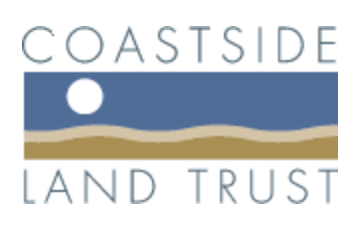The Audacity of 'Forever': What it takes to preserve lands for generations
©2007 Travis Harrison www.TravisHarrison.com
Our mission begins with acquiring coastal open space. But since we aim to preserve these scenic lands for generations, our job only begins with acquisition.
When we acquire a parcel, though donation or purchase, CLT must payfees to transfer title from the previous owner. Often there are back taxes due, too. And property taxes must be paid every year for every parcel, no matter how small.
Project Coordinator Eric Rutledge with 2013's property tax receipt
We are fortunate that almost all the legal assistance we need comes to us pro bono but sometimes we do also incur legal expenses.
As a land trust, we are required to monitor and file annual reports for each parcel we conserve. This reporting consumes lots of staff resources.
So you can see that expenses add up when you seek to protect open space forever! That's why your generous support is so critical to CLT's success. Thank you and please continue to make it possible for us to preserve our wonderful coastal lands.
How does the Coastside Land Trust protect land?
Coastside Land Trust protects urban open space on the San Mateo County Coastside by purchasing and receiving donations of land and conservation easements.
Every situation is different, and Coastside Land Trust offers several ways of conserving the urban lands of the San Mateo County coast.
You and your family can protect your property by working with the Coastside Land Trust to arrange a conservation easement, a donation of land, or a bargain sale of land to forever protect your own special landscape.
What is a conservation easement?
A conservation easement is a legal agreement between a landowner and a nonprofit land trust or government agency. In the agreement, the owner permanently restricts certain uses of the land in order to protect important scenic, wildlife, or agricultural resources (conservation values).
Each easement is different. An agreement to protect wildlife habitat might prohibit any development on a property, while one on a farm might allow continued farming and the construction of additional agricultural structures. An agreement may apply to just a portion of the property, and need not require public access.
The property owner donates the easement to the land trust, which then has the responsibility of enforcing the terms of the easement. The landowner can continue to use the property, and may sell it, or leave it to heirs, but the restrictions of the easement stay with the land forever.
What are the benefits of donating a conservation easement?
The donation of a conservation easement can benefit a landowner by protecting important resources without giving up ownership of the land, and allowing the land to pass along to heirs. It can also create tax advantages.
In January 2007, Congress passed a law to enhance the tax benefits of protecting your land by donating a voluntary conservation easement. If you own land with important natural or historic resources, donating a voluntary conservation agreement can be one of the smartest ways to conserve the land you love and protect our natural heritage, while maintaining your private property rights and possibly realizing significant federal tax benefits.
These new incentives make it easier for average Americans, including working family farmers and ranchers, to donate land.
Please contact us for more information about the benefits of donating a conservation easement to Coastside Land Trust.
How do I know what kinds of limitations an easement might place on my property?
Each conservation easement is specific to a particular property and landowner. Coastside Land Trust writes each conservation easements after several meetings with the landowner, and drafting and redrafting the document until all parties are satisfied.
What are the benefits of a land donation?
Donating your land to Coastside Land Trust, a 501(c)(3) nonprofit, can result in a substantial income tax deduction. We can work with you to structure the donation in a way that allows you or your family to continue to live on the property, or to receive a life income.
What is a bargain sale of land?
In a bargain sale, the property owner sells the land for less than its fair market value. This not only makes the land more affordable for Coastside Land Trust, it also offers you several benefits. It can provide cash, help decrease capital gains tax, and can entitle you to an income tax deduction based on the difference between the land’s fair market value and its sale price.
What type of property does Coastside Land Trust want to protect with purchase and conservation easements?
Coastside Land Trust is the only organization dedicated entirely to the protection and preservation of land in the urban Midcoast. We take a strategic approach to land conservation in Half Moon Bay, El Granada, Miramar, Moss Beach, Princeton-by-the-Sea, and Montara, and consider protecting lands that are valuable urban open space, property that has environmental or agricultural value, and scenic lands.
We evaluate each property individually to assess its resources and their value to the community.
Should I consider protecting my property?
If you own land within the City of Half Moon Bay or in the communities of El Granada, Miramar, Moss Beach, Princeton-by-the-Sea, or Montara, Coastside Land Trust may be able to help you preserve your property.
Please contact us if you are interested in receiving more information in the mail, or would like to set up a meeting to discuss how best to protect your land.
What types of motorized recreation are allowed on CLT land?
CLT prohibits the use of motorized recreation on its properties, except to meet ADA (Americans with Disabilities Act) compliance. This prohibition includes, but is not limited to, motorized scooters, dirt bikes, ATVs, radio-controlled model vehicles and aircraft, and drones.






